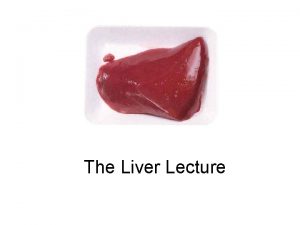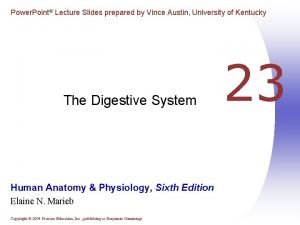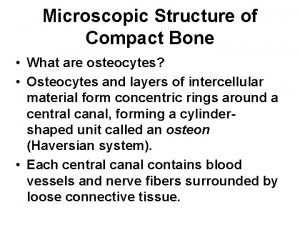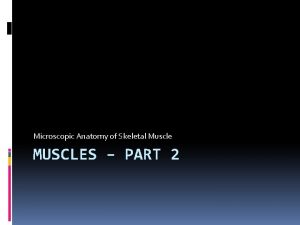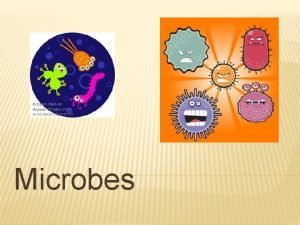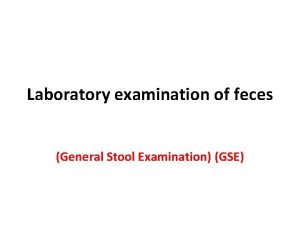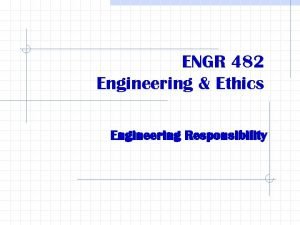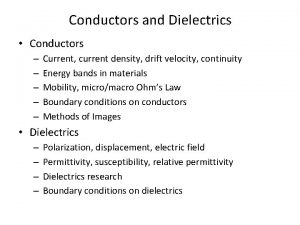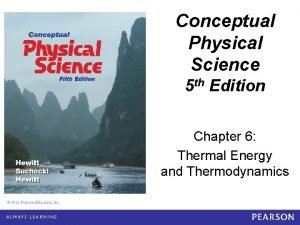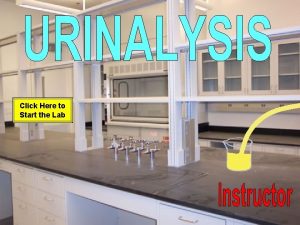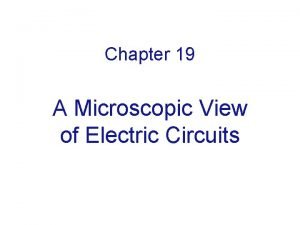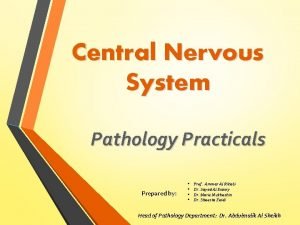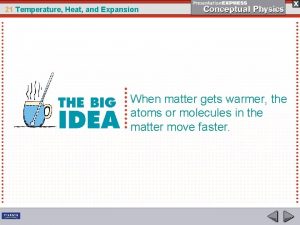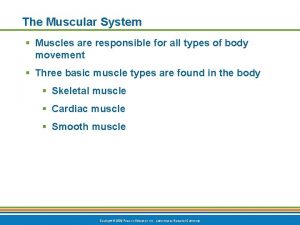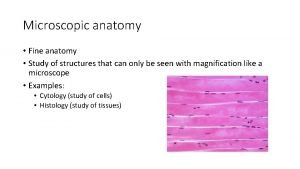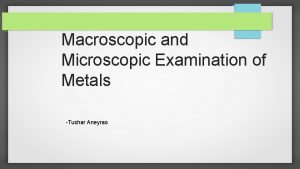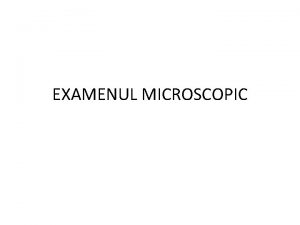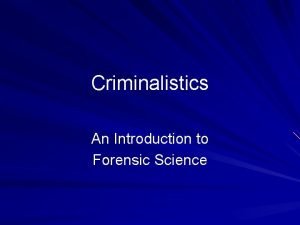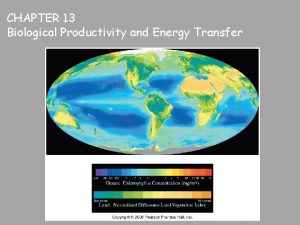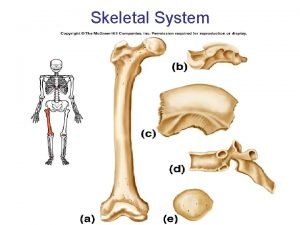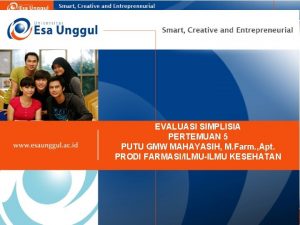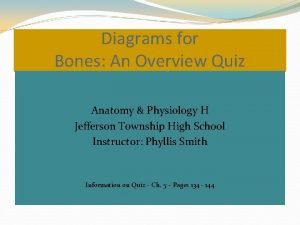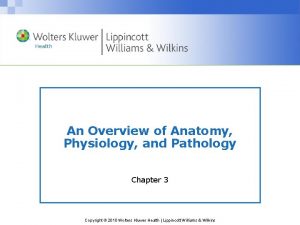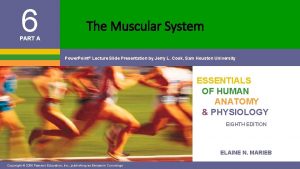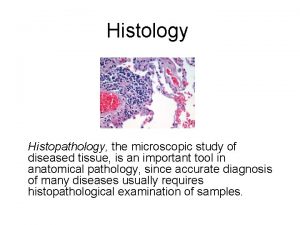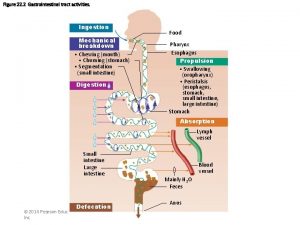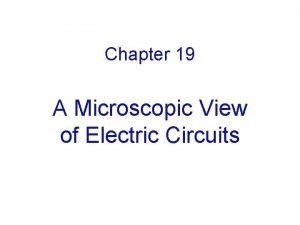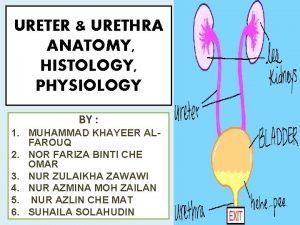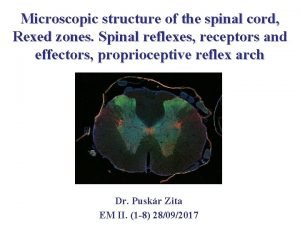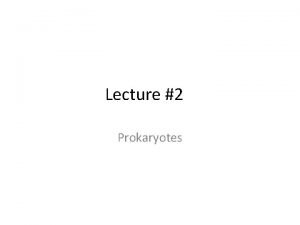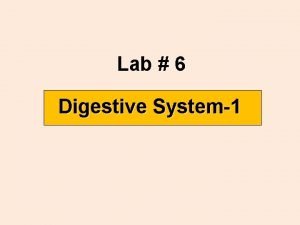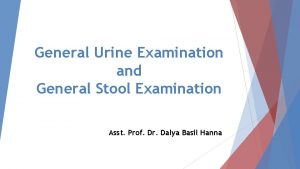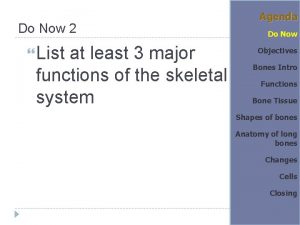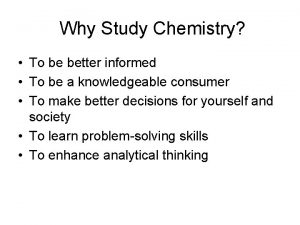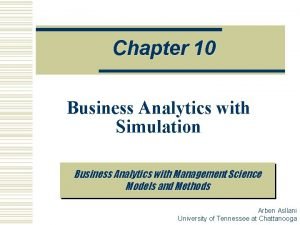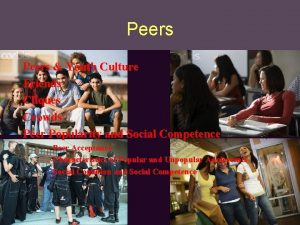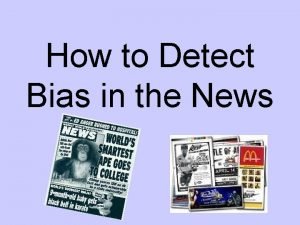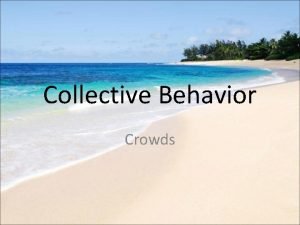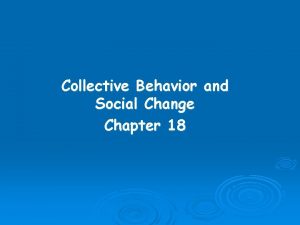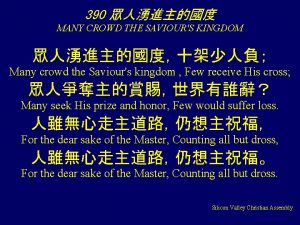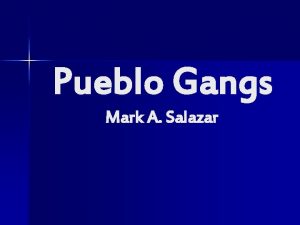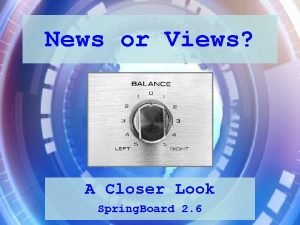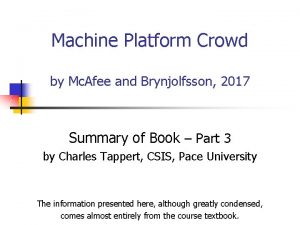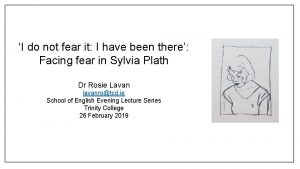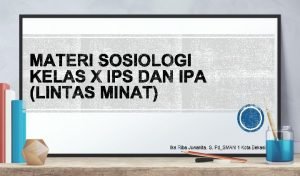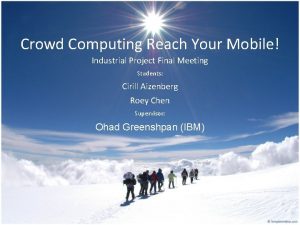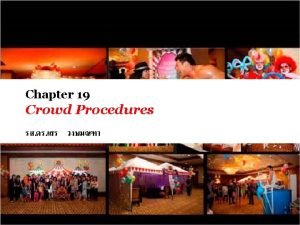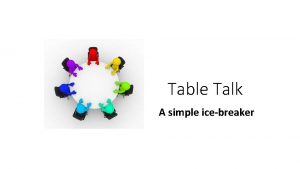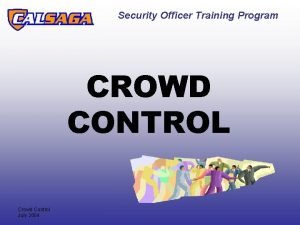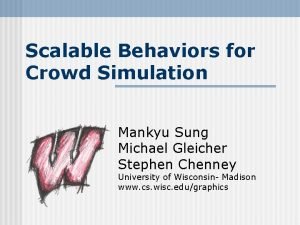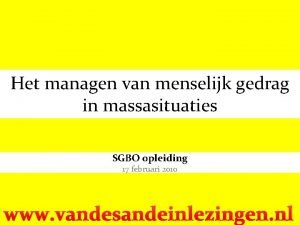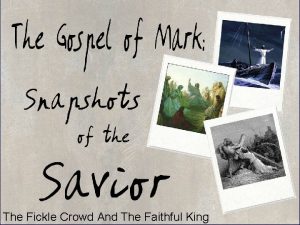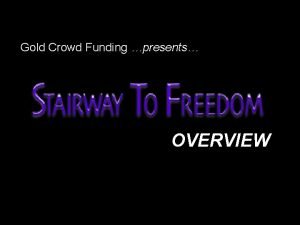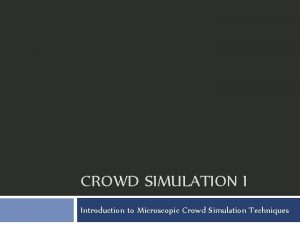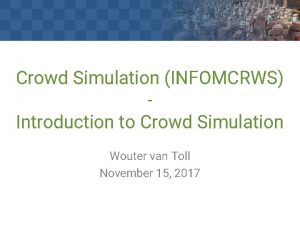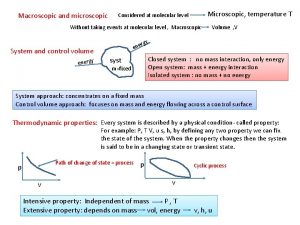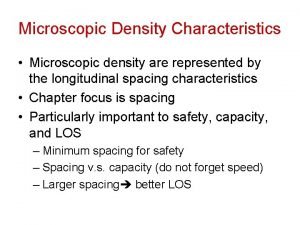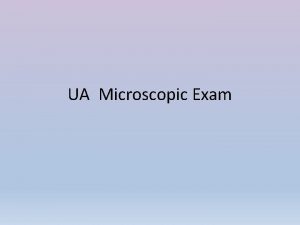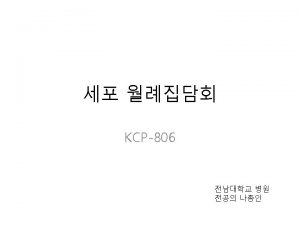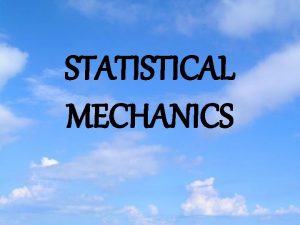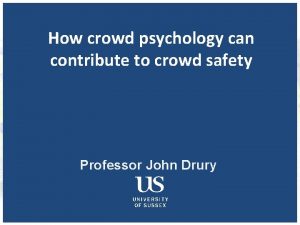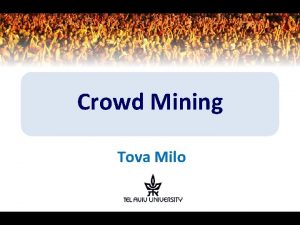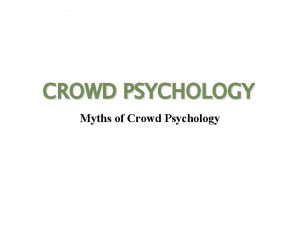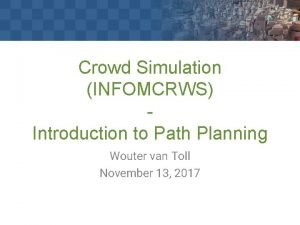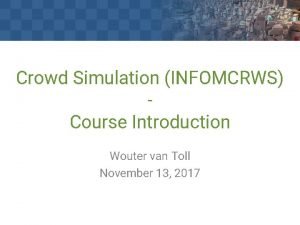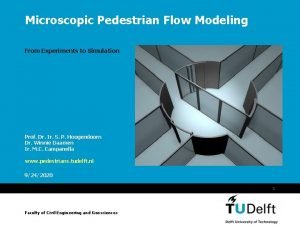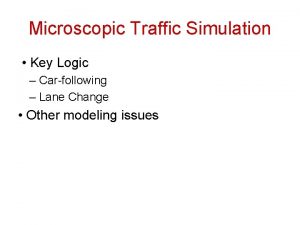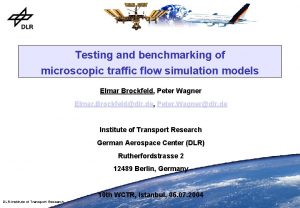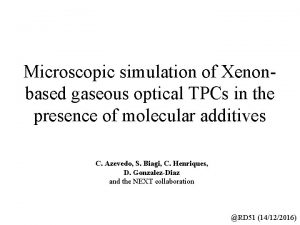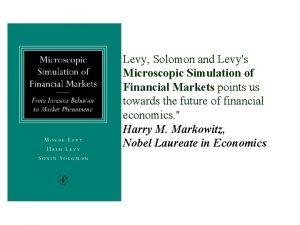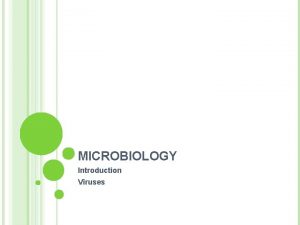CROWD SIMULATION I Introduction to Microscopic Crowd Simulation



























































![2 D Cellular Automata – Movement (3) σ is confined by range [σl, σh]: 2 D Cellular Automata – Movement (3) σ is confined by range [σl, σh]:](https://slidetodoc.com/presentation_image_h/26d3c0f1da07899c315559997e93742e/image-60.jpg)
















- Slides: 76

CROWD SIMULATION I Introduction to Microscopic Crowd Simulation Techniques

Outline Introduction to Crowd Simulation � Fields of Study & Applications � Visualization vs. Realism � Microscopic vs. Macroscopic Flocking Social Forces 2 D Cellular Automaton

Introduction Crowd simulation attempts to model the motions of objects within an environment. The topic has been researched from several different areas of study: � Entertainment and Visual Effects � Architecture and Civil Engineering � Psychology � Computer Science

Applications of Crowd Simulation Entertainment and Visual Effects � Goal: Create a visually realistic model of crowds for use in movies, television, and video games. Architecture and Civil Engineering � Goal: Study the flow of people/vehicles through environments. Psychology � Analyze road network efficiency. Building evacuation characteristics. Goal: Validate behavior models of the human mind under different environmental conditions (ex. panic). Computer Science � Goal: Help out in any of the three areas above with algorithmic know-how. Study AI models and behavior.

Visualization vs. Realism The various crowd simulation techniques can generally be divided into two categories: � Visualization Entertainment and Visual Effects � Realism Architecture and Civil Engineering Psychology Techniques have begun to merge over the last decade.

Crowd Visualization Goal: Create a visually realistic model of crowds. � Simulation does not have to be physically accurate. Techniques may have to integrate with motion captured animations. Algorithms frequently exploit Level-of-Detail. � Movies and television applications can afford offline processing as long as simulation time is reasonable. � Video games have real-time requirements.

Crowd Visualization Lord of the Rings Trilogy (2000 – 2003). Using the tool “Massive. ” Disney’s Lion King (1994).

Crowd Realism Goal: Study the flow of people/vehicles through environments. � Must be as physically accurate as possible. Studies constantly compare simulation results with empirical data. Simple visualizations such as a single point per object. � May have a very high order of objects to simulate.

Crowd Realism Simulation of a ship evacuation, using the tool EXODUS. Paths of pedestrian exploration driven by space syntax architectural concepts.

Microscopic vs. Macroscopic Simulations techniques can also be categorized as microscopic vs. macroscopic. � Microscopic techniques simulate the individual object. Crowd behavior is an emergent property of the microscopiclevel algorithms driving the simulation. � Macroscopic techniques simulate groups of objects. Example: Treating a transit system as a flow problem. The rest of this lecture will study three different approaches to microscopic crowd simulation techniques.

FLOCKING

Flocking technique introduced by Craig W. Reynolds and his Boids. � Techniques to simulate animal flocking, herds, and schooling. � Sets the stage for further study into crowd simulation. � Each agent in the simulation is called a “boid. ” Big Idea: Complex crowd behaviors can be achieved through individual agents following simple rules.

Demos Boids: � http: //www. red 3 d. com/cwr/boids/applet/ Disney’s Lion King: � http: //www. youtube. com/watch? v=ru. Nv 7 u. ATZTQ How was this done?

Flocking – Geometry in Flight Each boid has its own local coordinate system: � X axis is left/right � Y axis is up/down � Z axis is ahead/back Rotations too: � Rotation about X is pitch � Rotation about Y is yaw � Rotation about Z is roll Each boid moves along its positive Z axis where pitch and yaw realign the global orientation of the Z axis.

Flocking – Geometry in Flight (2)

Flocking – Geometry in Flight (3) For realism in the simulation… � Momentum is conserved. � Speed dampening achieved by setting a maximum speed and acceleration. � Gravity is only used for banking of boids. Banking orientation a function of path curvature and direction of gravity. Not physically realistic. Does not capture that traveling up is harder than traveling down.

Flocking – Steering Behaviors Flocking is closely related to particle systems. � Forces between particles cause motion. � Interactions take place within a local neighborhood of each Boid. Three basic steering behaviors: � Separation � Alignment � Cohesion Each steering behavior directs thrust in a desired direction.

Flocking – Steering Behaviors (2) Separation � Boids steer to avoid crowding local flockmates. Collision avoidance. Keeps boids a realistic distance apart.

Flocking – Steering Behaviors (3) Alignment (AKA Velocity Matching) � Boids attempt to match the velocity of their neighbors. Complements separation. Causes boids to move in the same general direction.

Flocking – Steering Behaviors (4) Cohesion � Boids steer to move towards the average position of local flockmates. Causes boids to keep together in a local flock. Allows flocks to both merge and bifurcate.

Flocking – Boid Brain Each steering behavior may yield a different thrust vector. The Boid Brain combines, prioritizes, and arbitrates between potentially conflicting urges.

Flocking – Boid Brain (2) Averaging (and weighted averaging) of steering vectors works “pretty well” but can yield poor behavior in cases where steering urges are in opposite directions. � Hesitation or indecision can lead to collisions with obstacles. � Example: (Turn -90 degrees + Turn 90 degrees) / 2 = 0.

Flocking – Boid Brain (3) Better Solution: � A fixed amount of “acceleration” is available to each boid each simulation iteration. � Steering vectors are processed in order of priority with a weighted average. Priorities may be reassigned dynamically. � Steering vectors are processed until all acceleration credits have been used up. The last processed vector is attenuated to keep within acceleration credit limits.

Flocking – Simulated Perception As mentioned earlier, boid perception is limited to a local field of view. Local neighborhood is a spherical zone of sensitivity centered around a boid’s origin. Sensitivity is weighted with the inverse exponential of distance. (1/r 2) � Early Boid implementation used linear weighting which yielded unrealistic spring-like animations. Additional parameters can be used to simulated different fields of view: � Extra weighting in forward direction to increase awareness of what is ahead.

Flocking – Simulated Perception (2) Implications of local perception: � Flocks of boids are allowed to bifurcate as groups of boids may break away from others and still satisfy the cohesion steering behavior. Global cohesion/centering models were used early in Boids’ development. Generated unusual effects causing all members of a scattered flock to simultaneously converge towards the flock’s centroid. � Spatially-oriented data structures may be used to reduce complexity below O(n 2).

SOCIAL FORCES

Social Forces Developed by Dirk Helbing and Peter Molnar in 1995 with several advancements over the last decade. � Later contributions from Illes Farkas and Tamas Vicsek. A frequently referenced piece of work. � Widely successful because it elegantly reproduces many common features observed in pedestrian movement.

Social Forces are not exerted by the environment on a pedestrian’s body, but rather a quantity that describes the motivation to act. � Respect personal space. � Follow others at a safe distance. � Avoid getting too close to walls and obstacles. Can be thought of as a developed model of “flocking for human pedestrians” as humans follow a set of social rules that guide their movement.

Social Forces ’ 95 – Equations Let’s work backwards. Here’s the equation describing all forces acting on an individual agent: Desired Motion Obstacle Avoidance Social Force Attractive Forces

Social Forces ’ 95 – Equations Acceleration towards a goal. � Given current location, desired location, current speed, and desired speed, an equation describing acceleration towards the destination is given by: � Where eα is a unit vector towards the destination. � The τα term is a relaxation time that causes a delay after the agent has performed deceleration processes.

Social Forces ’ 95 – Equations Respect the personal space of others. � Pedestrians will keep a certain distance from others that depends upon the pedestrian density and desired speed. This behavior can be implemented as a repulsive force between agents with the following equations: Where Vαβ is a monotonic decreasing function of b with equipotential lines having the form of an ellipse that is in the direction of motion. Elliptical range allows for an agent to leave room for their own subsequent steps. Helbing et al later revise and simplify this equation in 2000. This will be discussed in a little bit.

Social Forces ’ 95 – Equations Respect the personal space of others. (cont. ) � Pedestrians have a limited cone of vision, so forces from agents outside an agent’s immediate attention should be attenuated. This is done with the following weight function: � This gives us the final inter-agent repulsive forces: � Care must be taken for inter-agent forces to not cross between obstacles. For example, agents on opposite sides of a wall should not affect each other. �

Social Forces ’ 95 – Equations Avoid colliding with obstacles. � Pedestrians will also keep a certain distance from borders of buildings, walls, obstacles, etc. to avoid injury. This behavior can be described by the following: Where UαB is a monotonic decreasing potential. The vector rαB denotes the distance between the agent and the nearest portion of the obstacle.

Social Forces ’ 95 – Equations Social Forces also allows attractive forces. � Examples: Friends Street Performers Window Displays The equation for these forces has the same form as the inter-agent repulsive forces. This force is also attenuated with a field of attention, giving:

Social Forces ’ 95 – Equations Here is the final Social Force equation one more time: The social force model is now defined by: m/s 2 The fluctuation term takes into account random variations in behavior. Enhances realism.

Social Forces ’ 95 – Equations The previous equation described changes in acceleration. Changes in velocity are given by the following equation: m/s The trailing g-term caps speed.

Social Forces ’ 95 – Simulations Repulsive potentials were assumed decrease exponentially: Parameter values: � Voαβ = 2. 1 m 2/s 2 � σ = 0. 3 m � UoαB = 10 m 2/s 2 � R = 0. 2 m � τα = 0. 5 s (smaller times more aggressive)

Social Forces ’ 95 – Simulations (2) Two pedestrian phenomena were observed with these equations: � Lane Formation � Door Oscillation

Social Forces ’ 95 – Simulations (3) Lane Formation � The empty circles and full circles have desired direction of motion in opposite directions. � Circle diameter reflects actual velocity.

Social Forces ’ 95 – Simulations (4) Door Oscillation � If one pedestrian has been able to pass a narrow door, other pedestrians with the same desired walking direction can follow easily. Others have to wait. � The door can be “captured” as pressure on the opposite side builds up, allowing pedestrians in the other direction to pass.

Social Forces – Additions Several additions to Social Forces has been made over the years. In 2000, the equations were revised to study panic and evacuation dynamics. Characteristics of panic: � � � � � People move or try to move considerably faster than normal. Individuals start pushing each other (violating repulsive forces from earlier work). Moving becomes uncoordinated. Arching and clogging appears at exits. Jams build up. Physical interactions in jams can build up to dangerous pressures, injuring people and breaking of obstacles. Injured people become obstacles to the rest of the crowd. People show a tendency towards mass behavior. Alternative exits are often overlooked or not efficiently used. The bold items were addressed in 2000.

Social Forces ’ 00 – Equations The revised inter-agent force equation is given by: “Body force” counteracts body compression. k is a large constant. “Sliding friction force” impedes relative tangential motion if pedestrians come too close. Κ is another large constant. Inspired by granular interactions. Obstacle repulsion force updated in the same manner.

Social Forces ’ 00 – Equations The desired direction of motion updated to also include mass behavior: Simulations found that a mix of both individual and mass directions worked best. � Panic (high mass behavior) is realized through a high pi value.

Social Forces ’ 00 – Simulations Arching/Clogging at exits:

Social Forces ’ 00 – Simulations Corridor widening can lead to bottlenecks:

Social Forces ’ 00 – Simulations Mass behavior and inefficient use of exits:

Social Forces – More Results Below shows the effects of fire, which is said to have a socio-psychological strength 10 x greater than a normal wall. Incapacitated agents are shown as full circles.

Social Forces – More Results (2) Suggestions for improved motion. � Environments more conducive to efficient motion are shown on the right.

Social Forces – More Results (3) Breaking of a corridor doorway into two helps in lane formation and avoid door clogging and oscillation.

Social Forces – More Results (4) Placing a column in front of an exit can alleviates problems due to arching by reducing pressure. � More efficient egress. � Fewer or no injuries. Injured agents are shown as full circles on the left.

2 D CELLULAR AUTOMATA

2 D Cellular Automata Definition (courtesy wikipedia): � “Cellular automaton (plural: cellular automata) … consists of a regular grid of cells, each in one of a finite number of states. The grid can be in any finite number of dimensions. Time is also discrete, and the state of a cell at time t is a function of the states of a finite number of cells (called its neighborhood) at time t − 1. These neighbors are a selection of cells relative to the specified cell, and do not change (though the cell itself may be in its neighborhood, it is not usually considered a neighbor). Every cell has the same rule for updating, based on the values in this neighborhood. ” Cellular Automaton commonly abbreviated as “CA. ”

Continuous vs. Discrete The Flocking and Social Forces models are examples of spatially continuous simulations. � Pros: Easy to support heterogeneous agents. Each agent may have unique parameter sets for such things as mass, maximum speed, aggressiveness. Agents may occupy fractional coordinates in space. � Cons: Obstacle avoidance is hard as distance to obstacles must be frequently computed. Obstacles may occlude forces between agents. Difficult to compute. Even with local neighborhoods, algorithms still have relatively complex runtimes. Difficulty scaling.

Continuous vs. Discrete (2) Why consider a CA approach? � IT’S FAST! � Pros: Obstacle avoidance is automatic. Cells are occupied or they are not. No spatial partitioning required. All forces are within local neighborhood which are captured through simple index lookups. No need to solve agent-agent force occlusion. Highly parallelizable and thusly highly scalable. � Cons: Very difficult to simulate heterogeneous agents. Very difficult to simulate variable pedestrian speeds. Not easy to integrate into a realistic visualization system.

2 D Cellular Automata The following is a description of work by C. Burstedde, K. Klauck, A. Schadschneider, and J. Zittartz. The authors develop a 2 D CA system for modeling pedestrian crowds. � Goal to replicate the phenomena generated by Social Forces. Lane formation Door oscillations Arching and clogging � By replicating these phenomena, they hope to prove CA is a valid approach to pedestrian modeling. Historical Note: Most cellular automata solutions are 1 D and in the domain of traffic analysis.

2 D Cellular Automata The 2 D CA pedestrian model presented here breaks an environment (floor plan) down into a grid of cells. � Each cell may be occupied by one particle (agent) or by an obstacle. � Particles move through the environment by moving to adjacent unoccupied cells.

2 D Cellular Automata – Grids There are three CA grids: � Primary Grid Space in which pedestrians live and move. Obstacles live here too. � Static Floor Field Grid of potentials that directs pedestrian flow. Different species of pedestrians (different goal destinations) have different static grids. � Dynamic Floor Field Grid that stores the “wake” or “trail” of pedestrians as they travel through the environment.

2 D Cellular Automata – Movement Burstedde et al’s work is a Vmax = 1 solution where particles may only move one cell per iteration/generation. Particles may move in 1 of 9 directions with probabilities denoted by Mij. (One direction is to stay put. ) � Each particle may have its own local probability grid. � If the target cell is occupied, the particle stays put.

2 D Cellular Automata – Movement (2) The movement matrix M, can be computed from desired average velocity and deviation. This gives {p-1, p 0, p 1} from parameters {v, σv} which corresponds to forward and backward movement. Repeat computation with parameters {0, σt} to compute set {q-1, q 0, q 1} which corresponds to transversal movement. Mij = qi * pj
![2 D Cellular Automata Movement 3 σ is confined by range σl σh 2 D Cellular Automata – Movement (3) σ is confined by range [σl, σh]:](https://slidetodoc.com/presentation_image_h/26d3c0f1da07899c315559997e93742e/image-60.jpg)
2 D Cellular Automata – Movement (3) σ is confined by range [σl, σh]: This region.

2 D Cellular Automata – Movement (4) Conflicts may arise as two or more particles may wish to move to the same unoccupied cell. � This can be resolved by choosing among relative probabilities*. The loser stays put. * Later simulations show that this complication is not really necessary. Random arbitration gives similar simulation results.

2 D Cellular Automata – Movement (5) To avoid pedestrians being trapped too long by others, add state counters to pedestrians to implement “happy” and “unhappy” states. State becomes “unhappy” if pedestrian is unable to make three desired moves consecutively. State becomes “happy” if pedestrian is able to make four desired moves consecutively. Use different Mij probabilities for each state.

2 D Cellular Automata – Movement (6) The particle’s movement probability grid is modified by the static and dynamic fields. � The probability for each action is computed by: pij = NMij. Dij. Sij � Dij is the modifier value from the dynamic field. � Sij is the modifier value from the static field. � N is a normalization factor to insure probabilities sum to 1. � Note: Formula for pij does not have to be a simple product. Generalized as pij = N f(Mij, Dij, Sij). f(…) may include exponentials for different behavior.

2 D Cellular Automata – Fields Particles have no intelligence and do not carry any complex state. How can Social Force phenomena be generated? � Through the use of secondary CA grids: static and dynamic.

2 D Cellular Automata – Static Field The static field simply directs particle flow through an environment towards a particle’s goal. � � It’s a potential field. Normalization factor counteracts small potential field values. The field does not change throughout the simulation.

2 D Cellular Automata – Dynamic Field Social Forces requires forces act from a distance greater than the CA’s immediate neighborhood. The Dynamic Field grid stores the “history” of particle movement and propagates the forces derived from movement. � Subject to diffusion and decay. Inspired by chemotaxis (example: ant trails).

2 D Cellular Automata – Dynamic Field (2) Rules for Dynamic Field CA: � If a pedestrian leaves a cell (x, y) the dynamic floor field Dxy corresponding to this cell is increased by ΔDxy. A virtual trace is left by the motion of pedestrians. � A certain amount of the field is distributed among the neighboring cells to model diffusion. Diffusion is necessary because pedestrians do not necessarily follow exactly in the footsteps of others. � The field strength is reduced by a decay constant δ to model decay of the field. Implies that the lifetime of the trace is finite.

2 D Cellular Automata – Dynamic Field (3) Dynamic Field In Action

2 D Cellular Automata – Algorithm Simulation Iteration Algorithm: 1. 2. 3. 4. 5. 6. Dynamic Field D is modified according to diffusion and decay rules. Determine the matrix of transition preference for each pedestrian. (NMij. Dij. Sij) Each pedestrian chooses a target cell. Resolve transition conflicts Execute transitions. Update Dynamic Field Dxy for all previously occupied cells.

2 D Cellular Automata – Simulations Lane Formation � Two different species of pedestrians traveling in different directions across the screen.

2 D Cellular Automata – Simulations (2) More Lane Formation (with two doors)

2 D Cellular Automata – Simulations (3) Door Oscillation � Species of light-grey pedestrians can be seen breaking through. break-throughs

2 D Cellular Automata – Simulations (4) Arching/Clogging � � Pedestrians exit the room. Arching is clearly visible around the exit.

2 D Cellular Automata – Simulations (5) A full simulation: Lecture hall evacuation.

2 D Cellular Automata – Extras Vmax > 1 simulations. � Pros: � Cons: � Better variable speeds. Parallel Update vs. Shuffled Update Path Crossing See Klupfel’s dissertation for more. Finer resolution. � Allow pedestrians to occupy more than one cell at a time.

References General � � Boids � � Reynolds C. W. : Flocks, herds, and schools: A distributed behavioral model. In Proc. SIGGRAPH ’ 87 (1987), pp. 25 -34. http: //www. red 3 d. com/cwr/boids/ http: //cs. unc. edu/~lin/COMP 259 -S 03/LEC/19 a. ppt http: //www. evl. uic. edu/vchand 2/projects/527/boids. ppt Social Forces � � � Ulicny B. , de Heras Ciechomski P. , Musse S. R. , & Thalmann D. : State-of-the-Art: Real-time Crowd Simulation. In Euro. Graphics 2006 Course on Populating Virtual Environments with Crowds. M. Schreckenberg, S. D. Sharma: Pedestrian and Evacuation Dynamics. Proceedings from the first Pedestrian and Evacuation Dynamics Conference, 2001. Helbing D. , Molnar P. : Social force model for pedestrian dynamics. Phys. Rev. E 51 (1995), 4282 -4286. Helbing D. , Farkas I. , Vicsek T. : Simulating dynamical features of escape panic. Nature (September 2000), pp. 487 -490. Helbing D. , Farkas I. , Molnar P. , Vicsek T. : Simulation of Pedestrian Crowds in Normal and Evacuation Situations. In Pedestrian and Evacuation Dynamics Conference (February 2001). 2 D Cellular Automaton � � � Burstedde C. , Klauck K, Schadschneider A. , Zittartz J. : Simulation of pedestrian dynamics using a 2 dimensional cellular automaton. (February 2001). Burstedde C. , Klauck K, Schadschneider A. , Zittartz J. : Cellular Automaton Approach to Pedestrian Dynamics. Proceedings from the first Pedestrian and Evacuation Dynamics Conference, 2001. pp. 87 -97 Klupfel H. L. : A Cellular Automaton Model for Crowd Movement and Egress Simulation. Dissertation (2003) for the University Duisburg-Essen, Germany.
 Microscopic anatomy of liver
Microscopic anatomy of liver Maroon stool
Maroon stool Art labeling activity figure 23.5
Art labeling activity figure 23.5 Microscopic anatomy of compact bone
Microscopic anatomy of compact bone Microscopic anatomy of skeletal muscle
Microscopic anatomy of skeletal muscle Microscopic organism definition
Microscopic organism definition Gse test
Gse test Impediment to responsibility
Impediment to responsibility Resistivity
Resistivity Ohm's law microscopic form
Ohm's law microscopic form Conceptual physical science 5th edition
Conceptual physical science 5th edition Virtual urinalysis lab answers
Virtual urinalysis lab answers Is a light bulb an ohmic resistor
Is a light bulb an ohmic resistor Nervous tissue in brain
Nervous tissue in brain Chapter 21: temperature, heat, and expansion answer key
Chapter 21: temperature, heat, and expansion answer key Microscopic anatomy of skeletal muscle figure 6-2
Microscopic anatomy of skeletal muscle figure 6-2 Dorsifelxion
Dorsifelxion It holds data, instructions, and information for future use
It holds data, instructions, and information for future use Example of microscopic anatomy
Example of microscopic anatomy Microscopic examination of metals
Microscopic examination of metals Coloratia gram etape
Coloratia gram etape Father of microscopic forensics
Father of microscopic forensics Microscopic algae
Microscopic algae Stages of healing of a bone fracture
Stages of healing of a bone fracture Evaluasi simplisia
Evaluasi simplisia Compact bone
Compact bone Direct microscopic count
Direct microscopic count Histopathology is a subdiscipline of microscopic anatomy.
Histopathology is a subdiscipline of microscopic anatomy. Microscopic anatomy of skeletal muscle figure 6-2
Microscopic anatomy of skeletal muscle figure 6-2 Microscopic transistor
Microscopic transistor Spermatozoma
Spermatozoma Study of diseased tissue
Study of diseased tissue Gastric pit
Gastric pit Microscopic view of current
Microscopic view of current Prostate function
Prostate function Neonlab
Neonlab Interneuron
Interneuron Microscopic energy
Microscopic energy Capillary condensation
Capillary condensation Prokaryotic reproduction
Prokaryotic reproduction Pyloric stomach
Pyloric stomach Nephratitis
Nephratitis Lacunae in bone
Lacunae in bone Cast in stool microscopy
Cast in stool microscopy Short bone diagram
Short bone diagram Is milk macroscopic microscopic or particulate
Is milk macroscopic microscopic or particulate Microscopic producers
Microscopic producers Ddsep 9 free download
Ddsep 9 free download Introduction to modeling and simulation
Introduction to modeling and simulation Simulasi adalah
Simulasi adalah Business analytics simulation
Business analytics simulation Rewards propaganda definition
Rewards propaganda definition Crowd vs clique
Crowd vs clique Bias through selection and omission examples
Bias through selection and omission examples Examples of bias through statistics and crowd counts
Examples of bias through statistics and crowd counts Examples of conventional crowds
Examples of conventional crowds Dispersed collective behavior
Dispersed collective behavior Many crowd the savior's kingdom
Many crowd the savior's kingdom Gangs in pueblo co
Gangs in pueblo co Facebook photos sting minnesota high school
Facebook photos sting minnesota high school Machine platform crowd summary
Machine platform crowd summary Strategy crowd
Strategy crowd Peanut crunching crowd
Peanut crunching crowd Ciri ciri storming
Ciri ciri storming Crowd computing projects
Crowd computing projects Spectator management
Spectator management Harmonic crowd breaker
Harmonic crowd breaker Crowd control training for security
Crowd control training for security Crowd scalability
Crowd scalability Crowd management betekenis
Crowd management betekenis Strategy crowd
Strategy crowd Fickle crowd
Fickle crowd Strategy crowd
Strategy crowd Crowd strategy
Crowd strategy Gold crowd
Gold crowd What are peeta’s injuries? how has he kept alive?
What are peeta’s injuries? how has he kept alive? Body paragraph
Body paragraph
